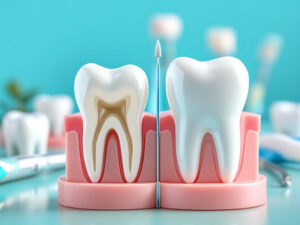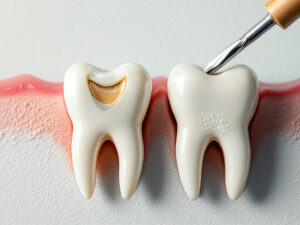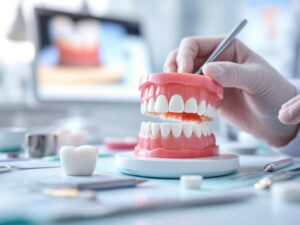Understanding Root Canal Treatment
Purpose of Root Canals
Root canals are essential procedures designed to preserve your natural tooth by removing infected pulp from inside the tooth. This treatment aims to eliminate bacteria, prevent reinfection, and maintain the tooth’s functionality. The procedure involves cleaning and sealing the root canals, ultimately saving the tooth from extraction. According to the Cleveland Clinic, root canal treatments are common and relatively painless, often completed in one or two appointments. Most patients receive anesthesia during the procedure, ensuring comfort similar to a standard dental visit.
| Purpose of Root Canals | Description |
|---|---|
| Eliminate bacteria | Removes infection from the root canal |
| Prevent reinfection | Seals the tooth to avoid future complications |
| Preserve natural tooth | Maintains tooth functionality and aesthetic integrity |
| Reduce ongoing dental work | Minimizes the need for further treatments |
Signs You Need a Root Canal
Knowing the signs that you may need a root canal is crucial for timely treatment. Common indicators include sensitivity to hot and cold, persistent tooth pain, swelling in the gums, or a visible boil on the gums. According to the American Association of Endodontists, root canal treatment may be necessary if you’ve experienced:
| Signs of Need for Root Canal | Description |
|---|---|
| Sensitivity to temperature | Pain when consuming hot or cold foods |
| Persistent toothache | Ongoing discomfort or pain in the affected tooth |
| Swelling or tenderness in the gums | Inflamed or sensitive gum tissue near the tooth |
| Visible abscess | A boil or pimple-like bump on the gum line |
If you notice these signs, it is essential to consult your dentist immediately. Early intervention can help you avoid more severe complications that could lead to tooth loss or require surgical extraction. For more detailed information about what to look for, check our article on signs you need a root canal. Understanding the purpose and signs of root canals can empower you to take charge of your dental health and preserve your natural smile.
The Root Canal Procedure
Understanding the root canal procedure will help you prepare for what to expect if your dentist determines that you need this treatment.
Duration of Root Canals
Most root canals take about 60 to 90 minutes to complete during a single visit. However, some cases may require more than one visit for full completion (Cleveland Clinic). The exact duration can vary based on the complexity of the case. Here’s a simple breakdown:
| Duration | Description |
|---|---|
| 60-90 minutes | Typical duration for a single visit root canal |
| 2+ visits | Cases that are complicated or may involve multiple roots |
For more detailed steps of the procedure, refer to our resource on root canal procedure steps.
Benefits of Root Canal Treatment
Choosing to undergo a root canal can offer various advantages. The primary benefits include:
- Preservation of the Natural Tooth: This treatment allows you to keep your natural tooth, which is vital for chewing and maintaining dental alignment.
- Preventing Infection Spread: A root canal helps eliminate bacteria from the infected root canal, preventing the spread of infection to surrounding areas.
- Long-lasting Results: Success rates for root canal treatments are significant, often lasting many years, if not a lifetime (Cleveland Clinic).
- Pain Relief: This procedure can alleviate the pain caused by tooth infections or damage.
For further insight on whether a root canal is worth it, visit our article on is a root canal worth it.
Recovery After Root Canal
Recovery from a root canal procedure typically takes less than a week. While you may experience mild soreness or sensitivity after the procedure, prolonged pain is uncommon (Cleveland Clinic).
Here are some key points regarding recovery:
- Initial Recovery: Most patients feel fine to resume normal activities within a day or two.
- Sensitivity: Some sensitivity can occur, particularly when chewing, but should diminish over time.
- Pain Management: If pain persists beyond a few days, consult your dentist for proper management (root canal pain relief tips).
- Post-Procedure Care: It’s important to maintain oral hygiene while being gentle around the treated tooth. For more information, check our guide on root canal home care aftercare.
Overall, understanding the root canal procedure can encourage you to take the necessary steps towards maintaining your dental health and preserving your natural teeth.
Managing Pain and Discomfort
Managing pain and discomfort is an important aspect of the root canal experience. Understanding what to expect can help you feel more at ease during the procedure and throughout your recovery.
Pain Management During Root Canal
During the root canal procedure, modern anesthesia techniques ensure that pain is minimized. Most patients experience sensations similar to what one might feel during a filling, with some pressure noted but little to no pain. You will receive a local anesthetic to numb the affected area, allowing the dentist to perform the procedure comfortably (Cleveland Clinic).
If you do feel any discomfort during the procedure, inform your dentist immediately so that adjustments can be made. After the treatment, mild soreness is common as the anesthesia wears off. This discomfort is usually manageable with over-the-counter pain relief medications.
Here is a brief overview of pain management options during a root canal:
| Pain Management Option | Description |
|---|---|
| Local Anesthesia | Numbs the tooth and surrounding area, making the procedure comfortable. |
| Over-the-Counter Pain Relievers | Medications like ibuprofen or acetaminophen can alleviate mild post-procedure soreness. |
| Cold Compress | Applying a cold pack to the outside of the cheek can help reduce swelling and discomfort. |
For further tips on alleviating discomfort during recovery, check out our article on root canal pain relief tips.
Post-Procedure Sensitivity
After a root canal procedure, some patients may experience lingering sensitivity in the treated tooth. According to the Cleveland Clinic, recovery after root canal treatment typically takes less than a week, with possible ongoing sensitivity but no lasting pain. If you experience persistent pain that worsens, especially if it feels throbbing, it is recommended that you contact your dental provider for further evaluation (Cleveland Clinic).
The following table outlines common post-procedure symptoms and what you can expect during your recovery:
| Symptom | Description |
|---|---|
| Mild Soreness | Common after anesthesia wears off; can be managed with pain relievers. |
| Sensitivity to Temperature | Teeth may react to hot or cold; usually temporary. |
| Tenderness in Gums | Some tenderness is normal as the area heals. |
Maintaining good oral hygiene during your recovery can aid in healing. For aftercare tips, refer to our article on root canal home care aftercare.
Understanding these aspects of pain management and post-procedure sensitivity can significantly ease your mind when considering or undergoing root canal treatment. If you have further questions about the procedure, explore the section on what is root canal treatment, or refer to our comprehensive root canal FAQ for more information.
Risks and Complications
While root canal therapy is generally safe and effective, there are some risks and complications that patients may encounter. It’s important to be aware of these potential issues so you can make informed decisions about your dental care.
Potential Issues Post-Root Canal
After undergoing a root canal, you might experience some complications, although they are relatively uncommon. Persistent or increased pain can occur, potentially due to factors such as an undetected canal or inadequate cleaning during the procedure. This pain may require further treatment and could ultimately lead to the need for additional dental work.
Another issue that can arise is a rare communication between the tooth and sinus floor, particularly with upper molars. This condition can result in sinus-related symptoms, including congestion or sinus infections (Ironwood Dental Care).
| Possible Complication | Description |
|---|---|
| Persistent Pain | Uncommon pain that can arise from inadequate cleaning or undetected canal. |
| Sinus Communication | Rare condition that may occur with upper molars, leading to sinus issues. |
Allergic Reactions and Complications
Although rare, some patients may experience allergic reactions to materials used during root canal therapy, such as rubber dams or irrigation solutions. Symptoms of an allergic reaction can include itching, swelling, or, in more severe cases, difficulty breathing (Ironwood Dental Care).
When considering these potential risks, it’s wise to consult your dentist about any concerns or previous allergies you may have. Understanding these complications can help in assessing whether root canal treatment is the best option for you or if exploring alternatives might be more suitable. For more information on potential issues and solutions, see our article on root canal complications.
Recovery and Aftercare
Healing Process After Root Canal
Recovery from a root canal procedure typically takes less than a week. During this time, you may experience some lingering sensitivity, but not prolonged pain. If you notice any lasting discomfort, it is essential to contact your dental provider. The initial numbness from the procedure lasts about 2-4 hours, and most patients can return to daily activities, such as work or school, immediately following treatment.
| Recovery Milestone | Time Frame | Description |
|---|---|---|
| Numbness Wears Off | 2-4 hours | Avoid eating until feeling returns. |
| Initial Recovery | 1-3 days | Mild discomfort manageable with over-the-counter pain relievers. |
| Complete Healing | < 1 week | Most sensitivity subsides; follow-up if pain persists. |
Oral Hygiene Post-Root Canal
Maintaining proper oral hygiene is crucial for preventing infection and promoting healing after your root canal treatment. Following these practices can ensure your recovery goes smoothly:
- Brush Twice Daily: Use a soft-bristle toothbrush and fluoride toothpaste to gently brush your teeth, focusing on the treated area.
- Floss Daily: Carefully floss once a day to remove plaque and food particles between your teeth and along the gumline.
- Use Antimicrobial Mouthwash: Rinse with an antimicrobial mouthwash to help reduce bacteria in your mouth (Winnisquam Dental).
- Follow Post-Treatment Instructions: Adhere to any prescribed medications and attend follow-up appointments to check on your healing process (Ironwood Dental Care).
By prioritizing your oral hygiene and adhering to post-treatment care recommendations, you can help ensure a successful recovery from your root canal procedure. For more guidance, consider our resources on root canal home care aftercare and root canal recovery time.
Alternatives to Root Canal
Exploring alternatives to root canal treatment can provide you with options that align with your health philosophy and dental needs. Here, we’ll look into holistic approaches and non-traditional therapies that may help you preserve your natural teeth while minimizing discomfort.
Holistic Approaches and Alternatives
Holistic dentistry offers various alternatives to traditional root canal procedures, focusing on overall health benefits. Some key alternatives include:
- Direct Pulp Capping: This procedure protects the pulp by sealing it directly, ideally preserving healthy tooth structure.
- Indirect Pulp Capping: In this method, a protective dressing is applied to the pulp without directly exposing it to bacteria.
- Pulpotomy: This approach involves removing part of the pulp and sealing the remaining healthy tissue.
- Calcium Hydroxide or Alternatives: Used to promote healing and encourage new tissue growth, calcium hydroxide can be an effective option.
- Natural Remedies: Home remedies such as saltwater rinses or essential oils like tea tree oil can provide temporary relief but are not long-term solutions for infections (All Natural Dentistry).
For those desiring biocompatible materials, zirconia dental implants are a durable and aesthetically pleasing option after tooth extraction. Zirconia implants align with holistic principles and are favored for their compatibility with the body (All Natural Dentistry).
Holistic dentists tend to view root canals differently, suggesting that in some cases, opting for extraction might promote better long-term health. Understanding the risks and benefits involved in each approach is crucial in making informed decisions about your oral health.
Non-Traditional Root Canal Therapies
A notable non-traditional approach is the GentleWave® Procedure, which utilizes Multisonic and Ultracleaning® Technology. This method targets and cleans the root canal system effectively while minimizing the need for manual instrumentation. It aims to preserve the tooth’s natural functionality and structural integrity (Aria Dental Care).
These alternatives can be discussed with your dental care provider to understand their potential effectiveness based on your specific situation. It’s essential to weigh these options against traditional root canal treatments when looking to manage persistent tooth pain, sensitivity, or infection symptoms. For further insights, you can explore resources on what is root canal treatment or compare it with options like root canal vs tooth extraction.










